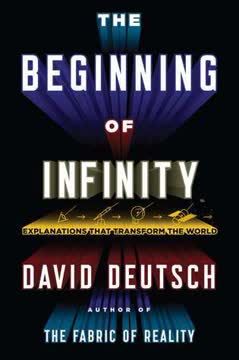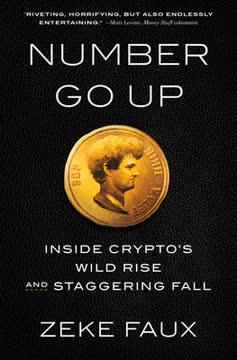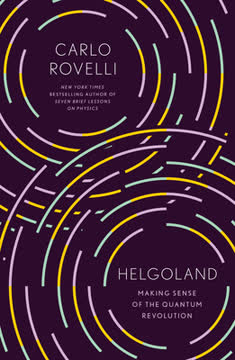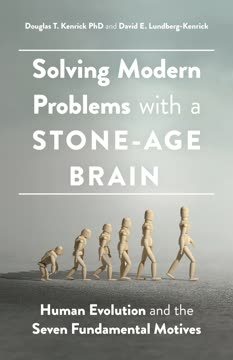Key Takeaways
1. The Myth of Social Darwinism Misrepresents Darwin and Hinders Progress
To a remarkable extent, Darwin’s theory stands falsely accused.
A historical misnomer. The term "social Darwinism" is primarily a pejorative label used to condemn policies justifying inequality and the strong exploiting the weak, such as laissez-faire capitalism, eugenics, and even genocide. However, the term was rarely used during the periods of its supposed influence (like the Gilded Age or the Nazi era) and those accused seldom actually based their views on Darwin's theory.
Darwin emphasized cooperation. Contrary to the stereotype, Darwin himself stressed the importance of cooperation and sympathy for human societal success, arguing that groups with these traits would outcompete selfish ones. Early thinkers like Malthus and Spencer, often associated with the term, had views on competition and social welfare that predated Darwin or differed significantly from his.
A bogeyman for biology. The widespread, inaccurate portrayal of social Darwinism has served as a "bogeyman" story, discouraging the application of evolutionary theory to human affairs in social sciences and humanities for over a century. Dispelling this myth is crucial to unlock the potential of evolutionary insights for understanding and improving human societies.
2. Darwin's Toolkit Provides Essential Conceptual Tools for Understanding Life
It is the theory that decides what we can observe.
Theory guides observation. Science isn't just observing facts; it requires a theoretical framework to know what to look for and how to interpret it. Just as Darwin and Sedgwick were blind to glacial evidence without the right theory, we can be blind to crucial aspects of the world without an evolutionary lens.
Tinbergen's Four Questions. To understand any trait (biological or behavioral), we must ask:
- Function: What is it for? (Its adaptive purpose)
- History: How did it evolve over generations? (Its evolutionary trajectory)
- Mechanism: How does it physically work? (Its underlying processes)
- Development: How does it develop during an organism's lifetime? (Its ontogeny)
Functional vs. Physical Reasoning. The toolkit helps distinguish between things designed for a purpose (like an avocado cuber or a bird's wing) and things resulting from purely physical processes (like a snowflake). Applying functional reasoning where it doesn't belong (or vice versa) leads to confusion and flawed understanding.
3. Policy Must Be Deeply Informed by Biological Understanding
Hence, the policy must be based on a detailed understanding of biology.
Beyond traditional biology. Applying Tinbergen's toolkit reveals that seemingly non-biological issues, like public health, education, and even parenting, are profoundly biological because they involve the development and functioning of living organisms (humans) in their environments.
Evolutionary Mismatch. Adaptations evolved for past environments can tragically misfire in modern ones. Examples include:
- Myopia: Modern indoor environments disrupt eye development, leading to nearsightedness.
- Immune Disorders: Overly hygienic environments prevent the immune system from developing properly, contributing to allergies, autoimmune diseases, and even mental health issues.
- Child Development: Academically-focused early education or excessive screen time may disrupt developmental processes adapted for play and three-dimensional interaction, potentially harming long-term social and emotional skills.
Theory informs intervention. Just as germ theory revolutionized medicine, understanding evolutionary mismatches and developmental processes is essential for designing effective policies to address modern health and behavioral problems. Well-meaning policies based on incomplete theories can cause harm.
4. Evolution Explains the Problem of Goodness Through Multilevel Selection
Selfishness beats altruism within groups. Altruistic groups beat selfish groups. Everything else is commentary.
The evolutionary problem of goodness. While "evil" (self-serving behavior) is easy to explain evolutionarily, "goodness" (cooperation, altruism) is a puzzle because it often benefits others at one's own expense, making it vulnerable to exploitation within a group.
Multilevel Selection (MLS). The solution lies in understanding evolution operates at multiple levels:
- Within-group selection: Favors traits benefiting individuals over others in the same group (often leading to "evil").
- Between-group selection: Favors traits benefiting the group as a whole over other groups (often leading to "goodness" within the group).
The eternal contest. Goodness evolves when between-group selection is strong enough to counteract within-group selection. This explains phenomena like:
- Cancer: Selfish cells proliferate within a multicellular organism, a conflict suppressed by organism-level selection mechanisms.
- Chicken Experiment: Selecting the most productive individuals within groups led to aggressive, low-producing groups, while selecting the most productive groups led to cooperative, high-producing groups.
Organisms as cooperative groups. In rare cases, between-group selection is so strong it transforms a group into a higher-level organism (a "major evolutionary transition"), like the evolution of multicellularity or social insect colonies. Human morality is seen as a product of this process, suppressing within-group selfishness to enable cooperation.
5. Evolution Operates at Multiple, Rapid Timescales Beyond Genes
Once we appreciate that evolution goes beyond genetic evolution, however, we can begin to use our toolkit to understand the fast-paced cultural changes swirling all around us and even within us as actively evolving entities in our own right.
Beyond gene-centrism. While genetic evolution is fundamental, it's not the only evolutionary process. Evolution is simply variation, selection, and heredity (resemblance between parent and offspring), which can occur through mechanisms other than genes.
Rapid evolutionary processes:
- Immune System: The adaptive immune system rapidly generates antibody variation and selects those effective against pathogens within an individual's lifetime.
- Individual Learning: Trial-and-error learning (behaviorism) is a process of variation and selection of behaviors based on their consequences, allowing individuals to adapt within their lifetime.
- Cultural Evolution: The transmission of learned information across generations allows human populations to adapt and change at speeds far exceeding genetic evolution, enabling colonization of diverse environments and the rise of complex societies.
Layered evolution. These rapid processes are themselves products of slower genetic evolution. Our capacity for learning, our immune system, and our ability to transmit culture are genetically evolved adaptations. Understanding this layering is crucial for a complete evolutionary worldview.
6. Well-Functioning Groups Require Core Design Principles
Unfair inequality poisons collective efforts.
Groups as units of selection. Just as honeybee colonies are the primary unit of selection for many bee traits, small human groups have been a fundamental unit of selection throughout our history, shaping our psychology for cooperation.
Elinor Ostrom's Core Design Principles (CDPs). Nobel laureate Elinor Ostrom identified principles common to groups successfully managing shared resources, which apply to virtually any cooperative group:
- Strong group identity and purpose.
- Proportional equivalence between benefits and costs.
- Fair and inclusive decision-making.
- Monitoring agreed-upon behaviors.
- Graduated sanctions for non-compliance.
- Fast and fair conflict resolution.
- Local autonomy (for nested groups).
- Polycentric governance (for multi-group systems).
Universal needs. These principles address the universal challenge of suppressing within-group selfishness to enable cooperation. Groups implementing them, whether consciously or not, tend to be more successful, from Turkish fishers to schools and religious congregations.
Beyond obviousness. While seemingly sensible in retrospect, these principles are often violated in practice (e.g., in many schools or businesses) because dominant theories or short-sighted interests blind people to their importance. Evolutionary theory provides a framework for understanding why they are necessary.
7. Individuals Are Products of Social Interactions, Not Isolated Units
Chronic aloneness is injurious to our mental and physical health.
Beyond methodological individualism. The idea that individuals are the basic, self-contained units of society is flawed. What we measure about individuals (health, personality, success) is profoundly shaped by their social environment and interactions.
The Social Baseline Model. Research shows our brains and bodies are wired to expect social connection. Being alone in a stressful situation activates fight-or-flight responses, while the presence of a cooperative other (even just holding hands) calms the system. Our perception of challenges is even influenced by whether a friend is nearby.
The Nurture Effect. Prosociality and nurturance from others are master variables for human well-being. Children raised in nurturing environments develop assets, while those in indifferent or hostile environments develop liabilities. This isn't just psychological; it's rooted in our evolutionary history as a species adapted to cooperative group living.
Personal evolution. Individuals adapt to their social environments through learning (selection by consequences). This can lead to positive outcomes in nurturing environments or negative coevolutionary spirals (like parent-child tantrums) in dysfunctional ones. Interventions like Positive Parenting Programs (Triple P) or Acceptance and Commitment Therapy (ACT) can help individuals consciously guide their personal evolution towards valued goals by altering their responses and symbolic interpretations.
8. Large-Scale Societies Can Be Understood and Improved Through Multilevel Selection
To put it bluntly, when it comes to policy formulation, laissez-faire is dead.
Pre-Darwinian economics. The concept of laissez-faire, rooted in ideas of a natural, self-regulating order and individuals motivated solely by self-interest (Homo economicus), is fundamentally pre-Darwinian and scientifically flawed. Evolution shows that lower-level self-interest does not automatically benefit the common good.
Constructing the "invisible hand". While nature has examples of systems functioning well without lower units having the whole's interest in mind (like beehives), this "invisible hand" is a product of higher-level selection suppressing disruptive lower-level competition. For human societies, this invisible hand must be constructed through intentional design and regulation.
Scaling up cooperation. Human societies have scaled up dramatically over 10,000 years, from small tribes to mega-societies, largely through cultural evolution driven by between-group competition. This required developing "social physiology" (institutions, norms, religions) to coordinate behavior at larger scales and suppress within-group conflict.
Ages of Discord. Historical analysis (cliodynamics) shows that large societies like the USA swing between periods of relative equality and cooperation ("Ages of Unity") and periods of inequality and conflict ("Ages of Discord"). These swings reflect the ongoing tug-of-war between levels of selection. Understanding these dynamics is crucial for navigating current societal challenges.
9. Adaptability to Change Requires Managed Variation and Selection
Making our societies more adaptable won’t be easy, especially at larger scales, but it will be possible with the right blueprint provided here by evolutionary theory, multilevel selection, and a solid four-question approach.
Beyond static adaptation. Being well-adapted to a current environment is different from being adaptable to changing environments. Modern life demands rapid adaptation, but neither laissez-faire nor centralized planning effectively achieves this.
Managed evolution. Adaptability requires a managed process of variation and selection:
- Define clear targets for selection (desired outcomes).
- Generate variation (planned experiments, observing unplanned practices).
- Select based on performance towards the target.
- Replicate successful practices.
Examples from business. Intense competition in the business world has favored the cultural evolution of adaptability:
- Toyota: Uses continuous improvement ("Kata") involving bottom-up problem-solving (Andon cords), experimentation, and learning from failures to adapt its complex system.
- Rapid Results: Challenges small teams to achieve daunting goals quickly, fostering bottom-up innovation and incremental systemic change, applicable beyond business (e.g., international aid).
- Innovation Ecosystems (Rainforests): Regions like Silicon Valley foster innovation through a combination of diverse skills, high trust, informal policing, and a culture of experimentation and generosity, acting as cultural "mutations" that spread based on success.
Copying the process. Emulating success requires copying the underlying evolutionary process (variation, selection, replication), not just the current products or structures. This is often difficult and slow, highlighting the need for a conscious, theory-informed approach to spreading adaptability.
10. Consciously Evolving Our Collective Future is Necessary and Possible
There is no question in my mind that “this view of life” is the wave of the future.
Affirming Teilhard's vision. Modern evolutionary science confirms Teilhard's core ideas: humanity is a new evolutionary process, superorganisms exist (groups functioning as units), and expanding this organization to a global scale is theoretically possible.
The need for conscious evolution. Evolution is not inherently directed towards human well-being or planetary sustainability. Without conscious guidance, lower-level selection (individual, corporate, national self-interest) can lead to disastrous outcomes. We must choose planetary welfare as the target of selection.
A middle way. An evolutionary worldview offers an alternative to both failed laissez-faire and centralized planning. It advocates for designing and managing evolutionary processes at all scales, from personal habits to global systems, using variation, selection, and replication guided by clear, normatively valued targets.
Practical steps. We can all contribute:
- Become mindful of personal values and guide individual evolution (e.g., using ACT).
- Join and strengthen cooperative groups using Core Design Principles (e.g., Prosocial).
- Ensure groups contribute positively to larger systems.
- For those in positions of influence, implement evolutionary processes (managed variation/selection) for systemic change, empowering bottom-up participation.
The power of the worldview. The primary contribution of evolutionary theory is providing a unifying framework to understand why certain practices work and how they can be applied across diverse domains, accelerating the spread of solutions needed to navigate the challenges of the Anthropocene.
Last updated:
Review Summary
This View of Life explores applying evolutionary principles to human culture and policy. Reviewers found it thought-provoking but sometimes dry or oversimplified. Many appreciated Wilson's examples of evolutionary thinking applied to real-world problems, particularly in small group dynamics. Some felt the ideas weren't entirely novel. The book's advocacy for a global "superorganism" was controversial. Overall, readers found value in considering evolution's relevance beyond biology, though opinions varied on Wilson's specific arguments and policy recommendations.
Similar Books










Download PDF
Download EPUB
.epub digital book format is ideal for reading ebooks on phones, tablets, and e-readers.




